The soil covers our entire planet and corresponds to the most superficial part of the earth's crust. Exposed to the attack of atmospheric agents and living organisms, the soil is organized in layers recognizable to the naked eye, more organic towards the atmosphere or water (if submerged), more minerals towards the rocky part of the bottom. To facilitate their study, soil scientists have been divided into three sections by soil scientists: Humipedon (surface part richer in organisms), Copedon (central part, junction, mineral) and Lithopedon (part still in contact with the unaltered rock) . This presentation describes an illustrated review of the variability of humipedons on planet Earth, classified into different humus systems.
- humus form
- humus
- soil
- litter
HUMIPEDON
INTRODUCTION
The founding fathers of pedology of the past century (Dukuchaev, Jenny, Hartmann, Stevenson, Leadley Brown, Duchaufour, all the original FAO group, and many others ...)[1][2][3][4][5][6][7][8] were looking for pedogenetic processes. Their classifications were "morpho-functional" (take note of those morphological aspects that facilitate the recognition of a specific type of soil functioning). In 2003, 26 European forest soil specialists met in Trento (Italy) to take stock of the situation on the classification of the organic and organo-mineral topsoils. In 2004 the group presented a first proposal of European reference at the Eurosoil Congress in Feibourg[9]. Since 2018[10] the the organic and organo-mineral top section of a soil is called "Humipedon". The humipedon is a living matrix that covers the whole planet. If you like Lovelock's concept of Gaia[11], you can see humipedon as a living film that encompasses like a skin the solid core of pour planet. This membrane is not uniform. It is built by living beings in equilibrium with the rest of the system. These living populations are dependent on the environment in which they develop, and adapt to it by changing both the environment and themselves over time, evolving with the planet as a whole. The ecologist's game is to discover how this matrix changes and goes over time, and how it interacts with the rest of the livings on the surface of the planet Earth. Because at the soil surface, what is alive or dying joins with what will come out from the ashes. It looks like a religious tale. It is only mysterious because little known, inhabited by invisible beings or strange small beasts, which can be scary only if magnified by the lens. Observed to the naked eye, a humipedon is composed of layers (called horizons by soil scientists) superimposed as in a sandwich with a total thickness varying from a few millimeters in the initial and young humipedons up to an average of about ten centimeters in the more mature ones, with exceptions of even several meters in peat bog environments.
DEFINITIONS
Humipedon: organic (codes: H, O) and organo-mineral (code: A) horizons of a soil.
Organic horizons (codes: H, O) are formed of dead organic matter (OM), mainly leaves, needles, twigs, roots and, under certain circumstances, other plant material such as mosses and lichens or remains of hydrophytes. This OM can remain not or little transformed when submerged (H: HF, HM, HS horizons) or be transformed in animal droppings following ingestion by soil/litter invertebrates and/or slowly decayed by microbial (bacterial and fungal) processes (OL, OF, OH horizons). A limit of 20% organic carbon (OC) by mass was established to define O horizons.
Organo-mineral horizons (code: A) are formed near the soil surface, generally beneath organic horizons. Coloured by organic matter, these horizons are generally darker than the underlying mineral layer of the soil profile. In the soil fraction Ø < 2 mm of the A horizon, organic carbon has to be less than 20% by mass. There are terrestrial A horizons that are not or only periodically asphyxiated (maA, meA, miA, sgA, msA), or more or less submerged (anA, anaA).
A soil core may be parted in three sections[12]. By making a hole in the soil, it is possible to discover a "face" of the soil, called a profile, on which these sections subdivided in horizons can be seen:
a) Humipedon (horizons: H, O, A) [2] = organic and organo-mineral soil horizons;
b) Copedon (horizons: E, B)[13] = mineral soil horizons;
c) Lithopedon (horizon: C, and R layer) = rocky part of the soil, altered rock, top part of the solid Earth crust.
The Humipedon corresponds to the part of the soil richest in organic matter, pedofauna, miroorganisms, seeds and roots of plants (Figure 1). It is also the most active part of the soil, where the processes of mineralization and humification of organic matter take place as well as the making of the organo-mineral aggregate of the soil.
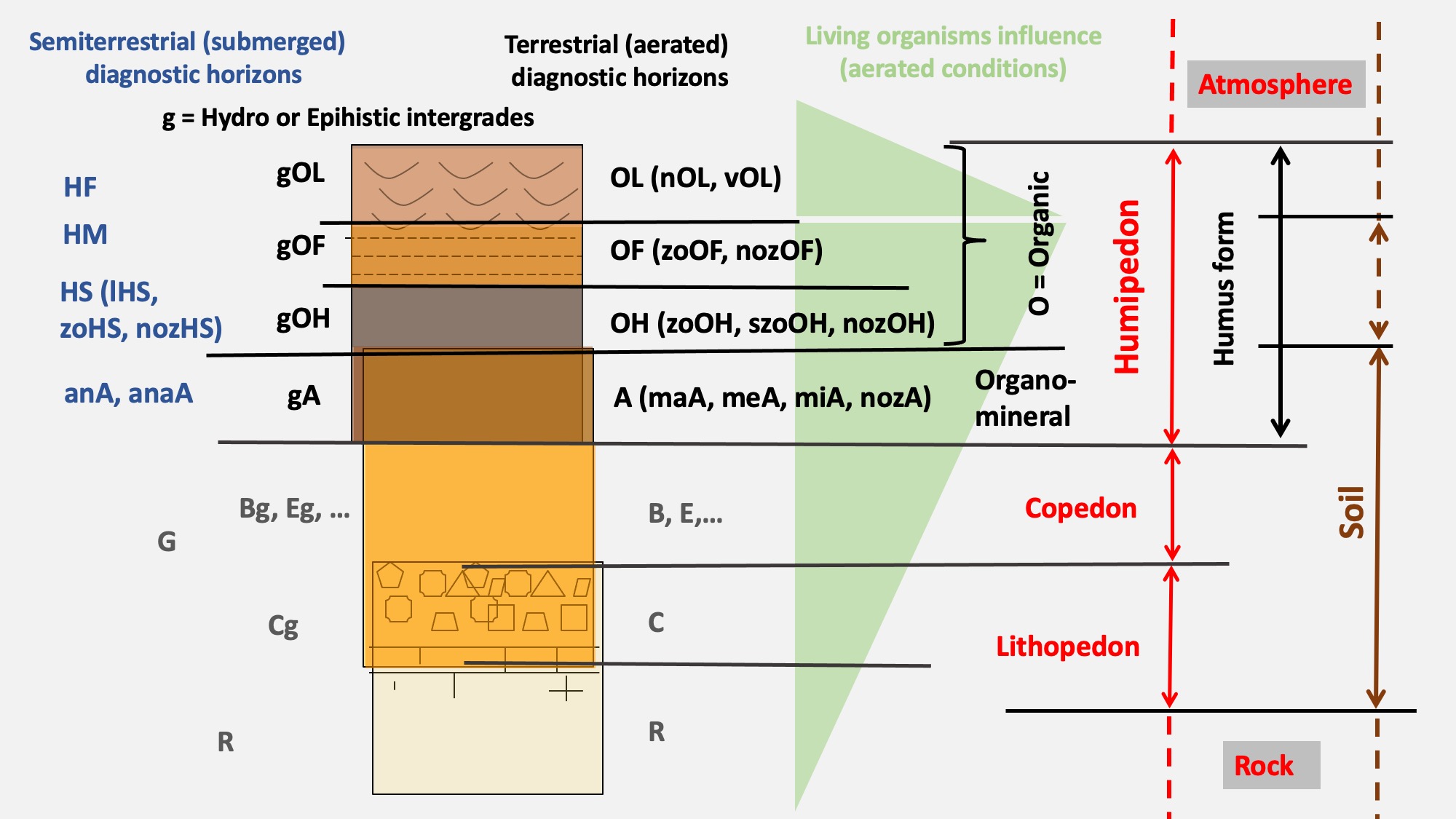
Figure 1. The distinction of Humipedon, Copedon and Lithopedon, with the list of diagnostic horizons in Terrestrial and Semi-terrestrial conditions.
The Humipedons cover the entire surface of the planet Earth. They are essentially the physical spaces where, at the same time, both the decomposition of dead organic matter and the reconstruction of new organic matter take place. Depending on the environment of genesis and development, humipedons are different, as they are created by different organisms in equilibrium with the environment and with each other. In summary, we can say that these processes depend on the possibility of "oxidizing" the organic matter in the air or in water and of making the components thus obtained interact chemically and physically to create new organic, organo-mineral or mineral structures, in more or less aerated environments. The pores of the matrix in which these processes take place may be filled by air or water in a dynamic exchange. The length of stay in the pores of water or air divides the humipedons into two broad categories: Terrestrial (long residence times of air = oxygen) and Semiterrestrial (long residence times of water = lack of oxygen). However, there are also particular conditions of birth and development of these humipedons. The "youngs" differ from the more developed ones. When young, they are highly dependent on external and dominant groups of organisms that build them and assign a recognizable appearance to humipedon. As they evolve, they converge into typical systems that we could define as "central references", characterized by a certain independence from the environment in which they develop. For this reason, central humus systems and satellite humus systems can be seen in Figure 2. The central systems were named Terrestrial (red on Figure 2), Histic (blue) or Aqueous (green); the satellite ones, Para (grey). In the central part there are also two Anthropogenic humus systems, named Agro and Techno (black).
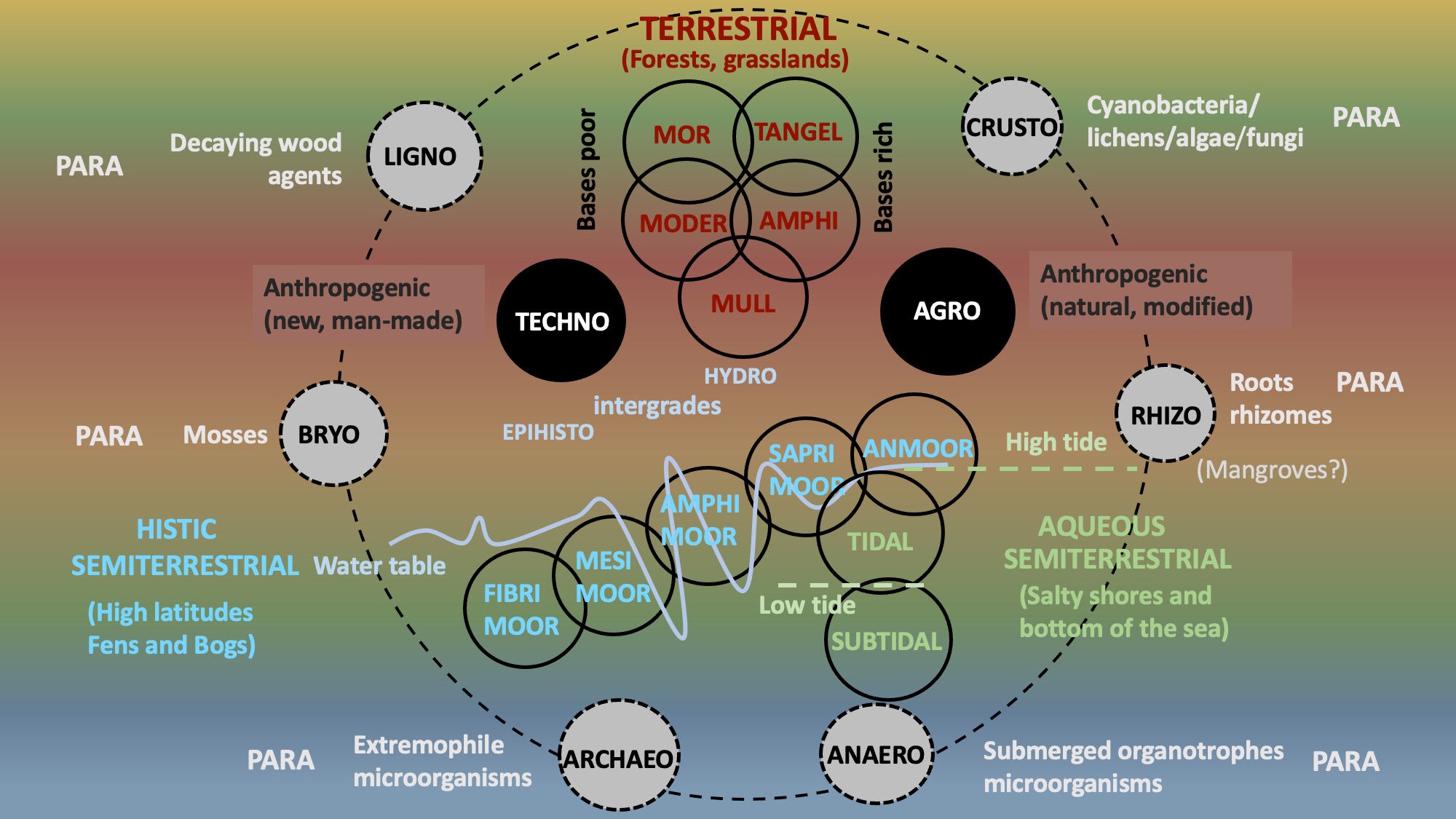
Figure 2. The humus system that cover planet Earth. Terrestrial (forests and grasslands): Mull, Moder, Mor, Amphi, Tangel; Histic (Fens and Bogs): Anmoor, Saprimoor, Anphimoor, Mesimoor, Fibrimoor; Aqueous (salty shores and bottom of the sea); Anthropogenic Agro (natural humipedons modified for agricultural purposes) and Techno (man made composts, dumps, hydroponic solutions,...). Para humipedons are represented as satellites of the "central" humipedons because they can either remain independent, or evolve towards the more developed ones, depending on the dynamics of the water and other ecological factors.
MAIN ECOLOGICAL GROUPS OF HUMIPEDONS
1 - Terrestrial[14]: not or submerged for a few days a year;
2 - Semiterrestrial:
2a - Histic[15]: submerged but not subjected to strong daily tides;
2b - Aqueous[16]: by the sea, in salt water and affected by tides with a daily rhythm.
3 - Para[17]: These are humipedons either of initial soils or of soils linked to specific "out of standard" environmental conditions. They are represented in gray circles on figure 2.
4 - Anthropogenic: Agro[18] or Techno humipedons. The former are Terrestrial, Semiterrestrial or Para humipedons modified by man to be cultivated. They contain diagnostic horizons similar to the original natural ones. Techno instead are: 1) maniure humipedons (the different types of composts), 2) soil-free humipedons (from hydroponic solution to porous clay balls), 3) dump humipedons (various types of landfills).
1. Terrestrial (Figure 3)
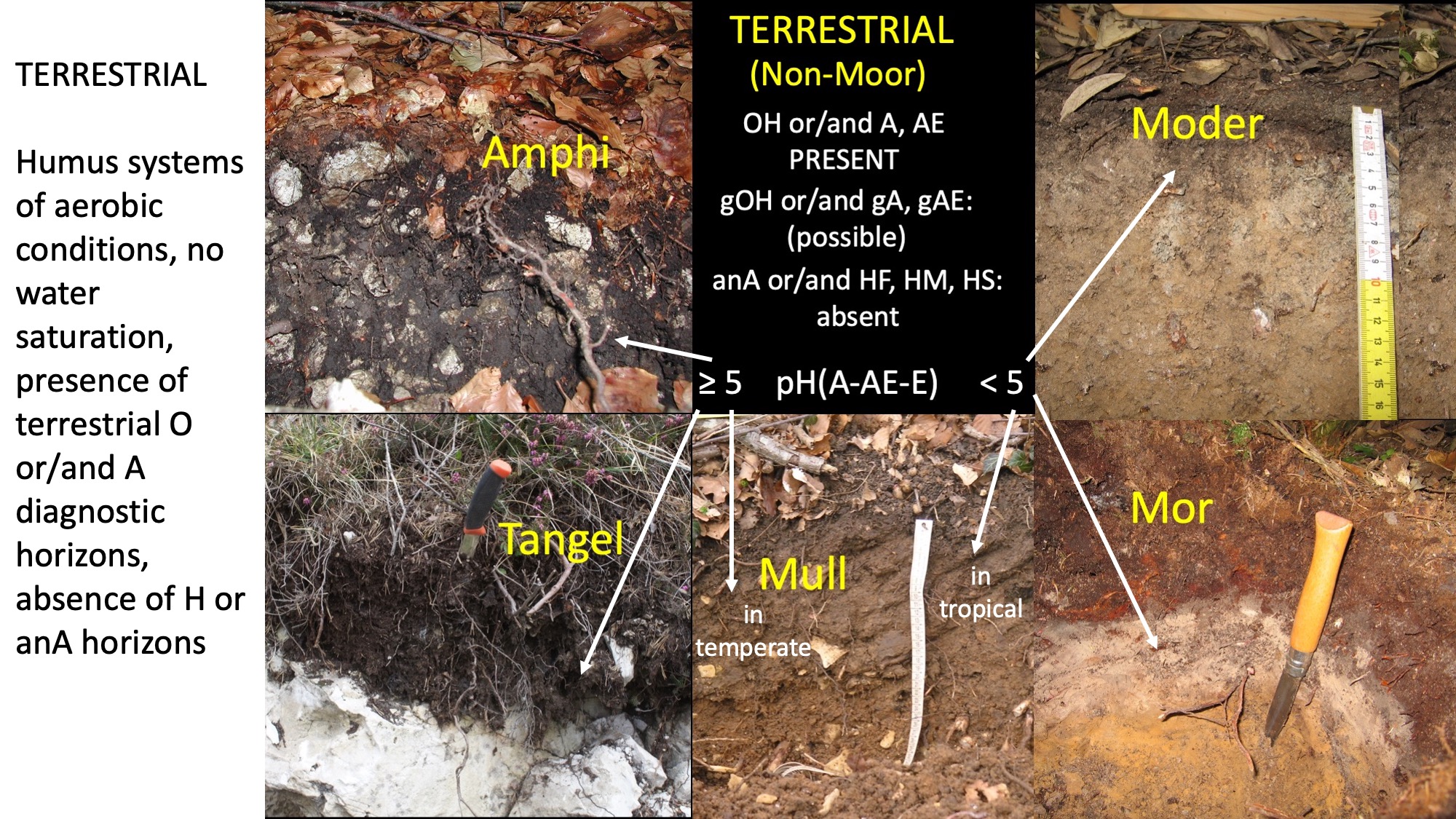
Figure 3. Terrestrial humus systems. We see that they are not in water and relatively dry. We are in forests, shrubs, grasslands, where you can walk without sinking. It is also seen that they have evolved, because they got a consistent thicknesses of about 5-50 cm. For this aspect concerning the evolution and thickness it is necessary to compare with Para systems. On this figure there are only forest and well developed humipedons. The Mull is made by animals that mix efficaciously organic matter and soil; no organic remains are seen with the naked eye when looking at the humipedon; the leaves become soil, organo-mineral lumps of soil, with the still uneaten litter that lays at the top, eventually. These animals eat all the litter that falls in the year, letting the soil nude before a new fall. The animals that originate this structure are earthworms or large insects larvae. What we call soil is 100% made of their excrement. The Mull is formed in temperate environments to which these animals are well adapted. The Mull is found is all temperate plains of the world. The environment changes as you go up in altitude, or go towards the Earth's poles. The actors of biodegradation and the formation of humipedons change. If the substrate is acidic, the humus system passes from Mull to Moder and then to Mor; if, on the other hand, it is carbonatic, it goes first to the Amphi and then to the Tangel. This is a general rule. In reality, it is also possible to meet Mulls in mountains sites and Mor in the plains, when the environment becomes locally temperate or protected in the first case, or decidedly acidic or difficult in the second. For a complete reading of the humipedon coverage it is also necessary to know the Para systems, which can be superimposed or juxtaposed with the more advanced ones. In the mountains, for example, the prairie is characterized by a Rhizo system under which a Mull system can develop. The dominant system is a Mull in the valley floor and in the lower part of the slope, the Rhizo becomes dominant when the humipedon is 10 cm or less thick, high on the clinal and near the outcropping rocks. To see illustrated examples of Terrestrial humus systems, please refer to:[19][20]
2 Semiterrestrial
Semi-terrestrial systems contain humipedon more or less related to environments rich in water. At first the peaty's were distinguished from the more mineral ones, then those with a more or less prolonged duration of the submersion cycle from those that had an hourly cycle linked to the tides. The latter are also generally saltier than the former.
2.a. Histic (Figure 4)
Fens and Moors.
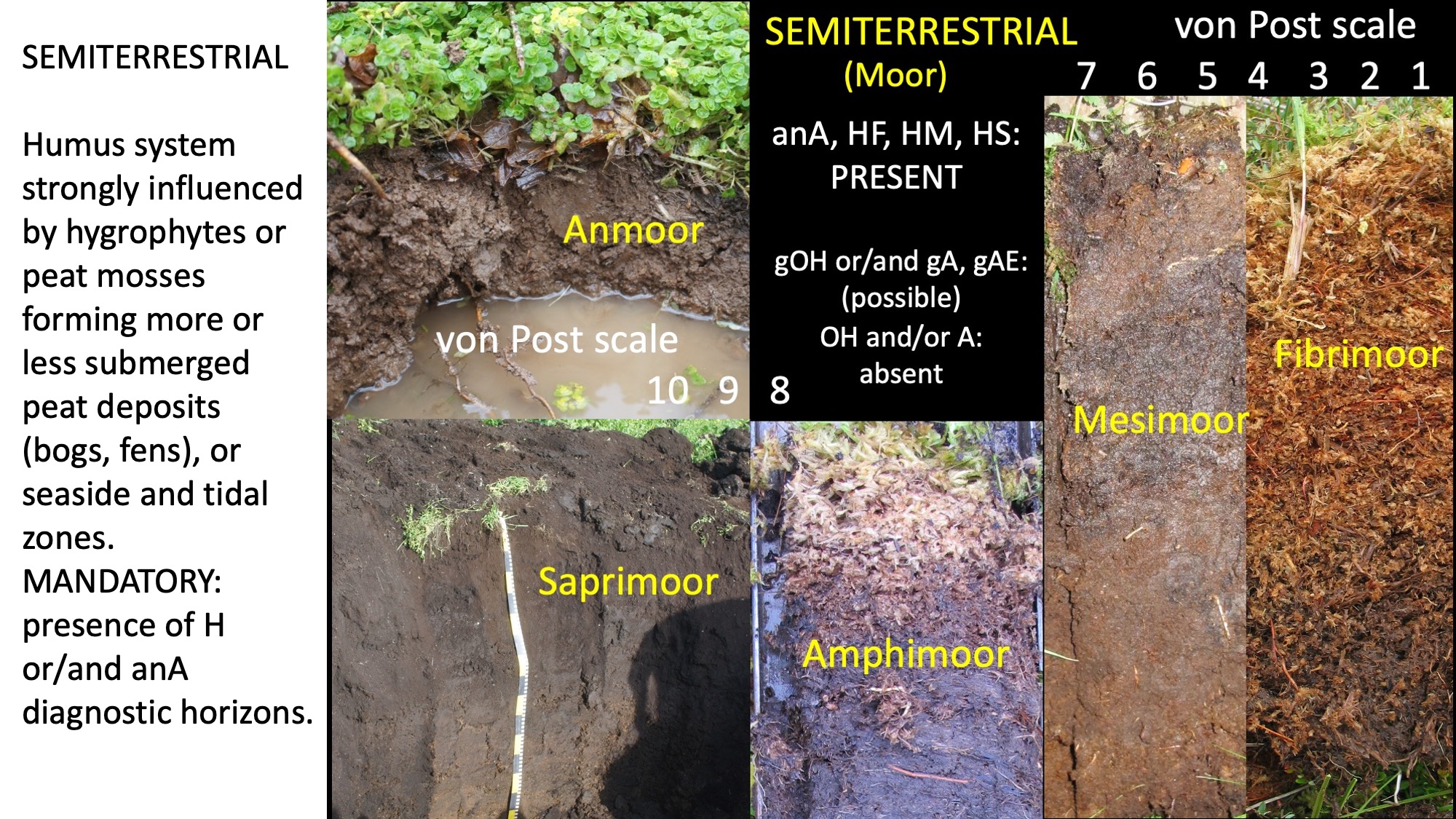 Figure 4. Semiterrestrial Humus Systems. In these environments there are hygrophilous plants and the rather organic matrix is generally dark. The figure shows the von Post scale which indicates the degree of decomposition of the vegetation in the humipedon horizons; this scale is low when the plant components are almost intact and visible, it becomes 10 when they have become dark soil. An easy way to distinguish the three main organic horizons is to squeeze a fistful of material: if clean water comes out, HF (little or not decomposed plant material von Post from 1 to 3); dirty water comes out, HM (von Post from 4 to 7); no water comes out but paste-soil if wet, HS (von post from 8 to 10). "Ana" (typical in Anmoor) is an organo-mineral diagnostic horizon, a paste similar to HS but with an organic carbon content ≤ 20%. Passing from left to right on the figure, we go towards increasingly submerged environments. To know more about these humipedons, refer to :[21][22]
Figure 4. Semiterrestrial Humus Systems. In these environments there are hygrophilous plants and the rather organic matrix is generally dark. The figure shows the von Post scale which indicates the degree of decomposition of the vegetation in the humipedon horizons; this scale is low when the plant components are almost intact and visible, it becomes 10 when they have become dark soil. An easy way to distinguish the three main organic horizons is to squeeze a fistful of material: if clean water comes out, HF (little or not decomposed plant material von Post from 1 to 3); dirty water comes out, HM (von Post from 4 to 7); no water comes out but paste-soil if wet, HS (von post from 8 to 10). "Ana" (typical in Anmoor) is an organo-mineral diagnostic horizon, a paste similar to HS but with an organic carbon content ≤ 20%. Passing from left to right on the figure, we go towards increasingly submerged environments. To know more about these humipedons, refer to :[21][22]
2.b. Aqueous
The Aqueous are still and strangely little studied. They would be very interesting because they correspond to the shallow edges of rivers, lakes, seas, oceans and tidal zones. They are the result of interaction with the remains and activities of aquatic microorganisms, animals and plants. They are different from Histic because they are more mineral, generally salty and with a clearer distinction between humipedons asphyxiated or periodically ventilated over the course of a day. They are certainly interesting for those who keep fish or crustaceans or aquatic animals in general. Basics of classification here:[23]
3. Para humus systems
The study of Para systems is not accidental. It is impossible to understand other humus systems without first observing what happens when they are young or different from the standard ones. The normal growth series of humus systems is this: few and invisible microorganisms on any substrate (they are called microbial films; growing, they become Anaero or Archaeo or Crusto in our classification, depending on the environment in which they generate; later they become Bryo, then Rhizo, ending in Terrestrestrial, or Semiterrestrial, or Aqueous systems (or Anthropogenic). If you look at them on Figure 5, you will find that you have already seen them somewhere. Other examples, here:[17]
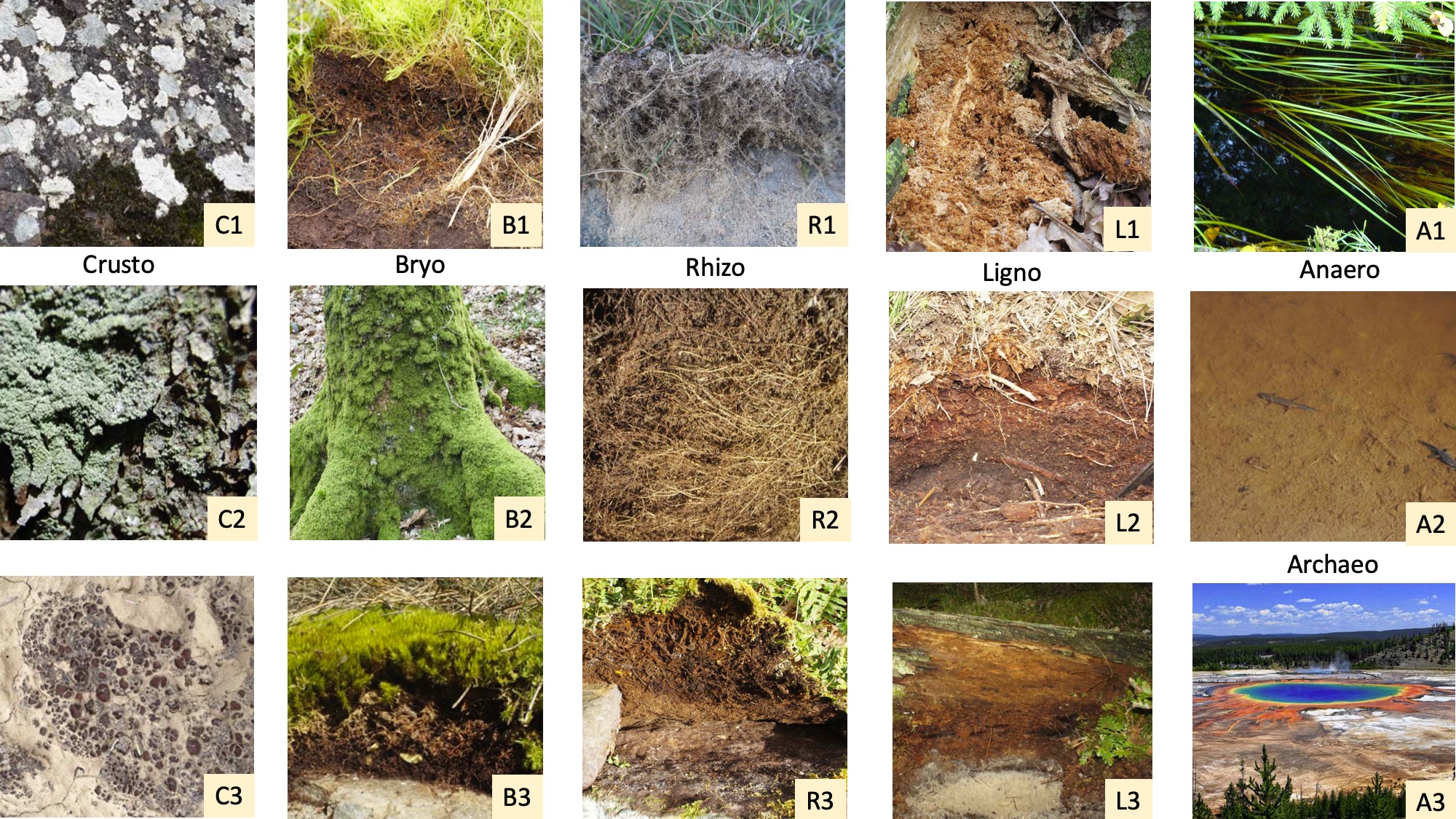
Figure 5. Para humus systems, in column from left to right, examples of Crusto, Bryo, Rhizo, Ligno, Anaero (A1,A2), and Archeo (A3).
4. Anthropogenic humus systems
Humans use humipedons to live (Figure 6). To produce the food we need, we change the vegetation cover by planting species of our own taste. In general, this turns all pre-existing natural humipedons into Agro Mull (or Agro Anmoor). A Rhizo Mull (Rhizo superimposed on Mull system)[24] is found in all graminaceous environments more or less grazed. Humipedons can also be completely artificial (Techno humus systems), as may be landfills, waste, concrete, compost heaps, even hydroponic solutions.
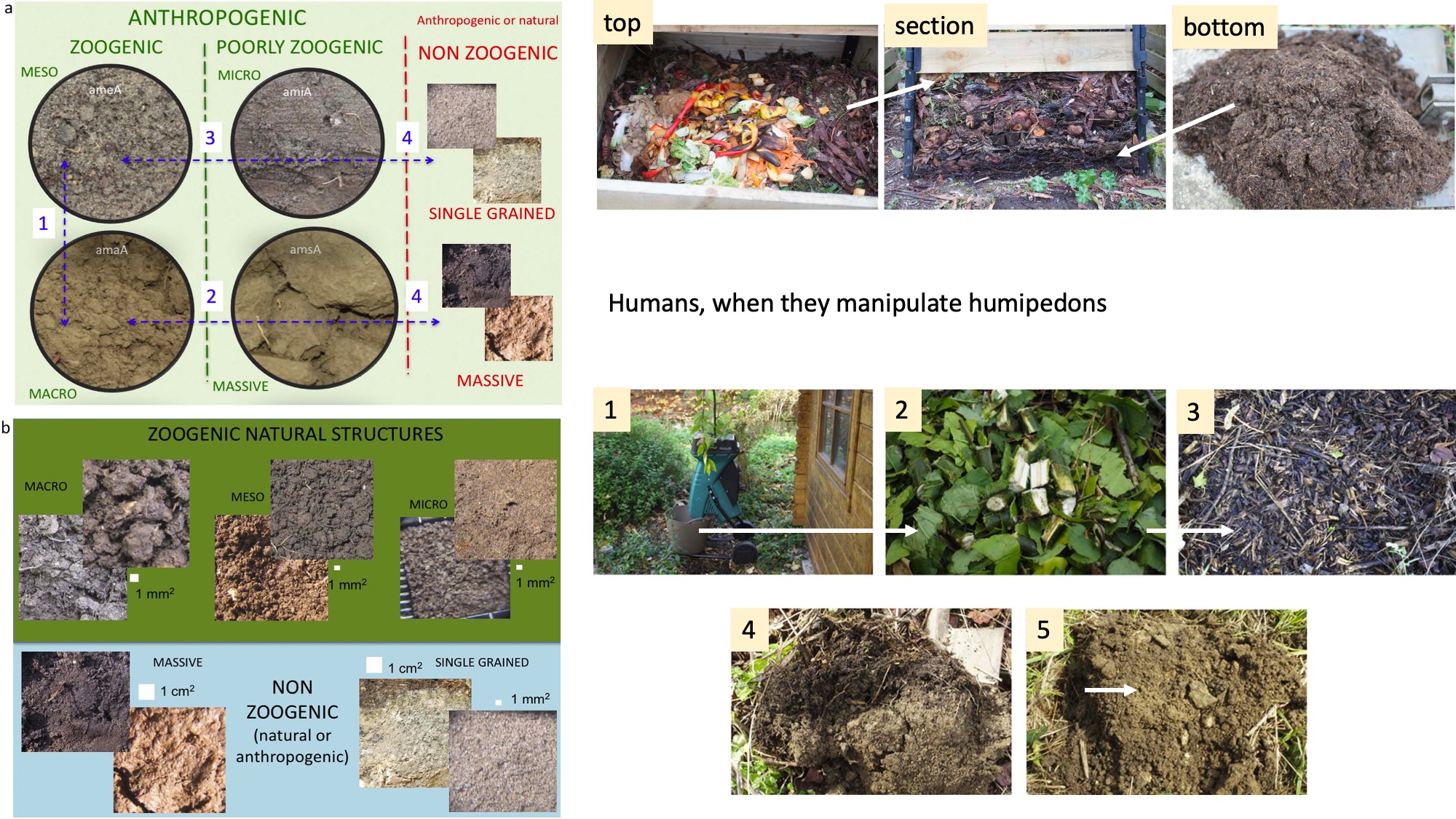
Figure 6. Agro Anthropogenic humus systems. a) and b): comparing natural and anthropogenic soil structures. Right part, homemade compost production (above), or direct and surface distribution of ground leaf and wood, to nourish the soil. To know more, please refer to:[18][25][17]
PERSPECTIVES
If this is the big picture, and if you want to cover the whole planet, this is just the beginning of the adventure. All the bottoms and seabeds of the world are missing (oceans, seas, lakes and rivers).
Organic soils such as peat are now considered humipedons by many soil scientists, we do not know what sense it makes to classify them considering only the first 40 cm, with the reason that this depth is the most interesting for humans. They are generally deeper and can reach depths of meters. They are generally deeper and can reach depths of meters. They also occur in areas that are thawing as a result of global warming, and we know little about how they will evolve. The frozen humipedons have not been classified.
We are far from having understood the morpho-functional difference between Mulls built by earthworms, compared to those built by other animals, such as larvae, crustaceans ... We do not yet have a list of animals, plants and microorganisms to associate with each humus system. DNA analyzes that have become much more affordable could help a lot in this type of research.
And the Para systems: they are a completely unexplored mine and of undoubted biological, ecological and economic interests. We presented them as systems, but humus forms could be created at will (that's why we stopped the classification at the level of system). Message to young people: life came from the soil (probably a very liquid soil); to understand the soil is to know ourselves.
References
- Dokoutchaief B.. Tchernozème (terre noire) de la Russie d'Europe; Soc. imp. libre économ. C.R. Soc. imp. libre économ. T. 4: St.-Ptb., 1879; pp. 1-66.
- Henry E.. Les sols forestiers.; Berger-Levrault Ed.: Paris-Nancy, 1908; pp. 485.
- Jenny, Hans. The Soil Resource, Origin and Behaviour; Springer-Verlag: New York, 1980; pp. 284.
- Kubiena, W.L.. Bestimmungsbuch und Systematik der Böden Europas.; F. Enke Verlag: Stuttgart, 1953; pp. 392.
- Hartmann, Frane. Der Waldboden Humus-, Boden- und Wurzeltypen als Standortsanzeiger; Österreichisches Produktivitäts-zentrum, Eds.; Ueberreuter: Wien , 1951; pp. 151.
- Stevenson, F.J.. Humus Chemistry: Genesis, Composition, Reactions, 2nd Edition; Dept. Agronomy University Illinois, Eds.; John Wiley & Sons, inc: New York, 1994; pp. 1-248.
- Leadley Brown, Alison. Ecology of Soil Organisms; Heinemann Educational Books: London, 1978; pp. 116.
- Duchaufour, Ph; Souchier, B.. Pedologie 1. Pédogenèse et classification; Masson, Eds.; Masson: Paris, 1977; pp. 1-477.
- Jabiol, B.; Zanella, A.; Englisch, M.; Hager, H.; Katzensteiner, K.; De Waals, R.. Paper « Eurosoil ». Towards a European Classification of Terrestrial Humus Forms. ; Albert Ludwigs Universität: Freibourg (Germany), 2004; pp. 10.
- Augusto Zanella; Jean-François Ponge; Jean-Michel Gobat; Jérôme Juilleret; Manuel Blouin; Michaël Aubert; Oleg Chertov; José Luis Rubio; Humusica 1, article 1: Essential bases – Vocabulary. Applied Soil Ecology 2018, 122, 10-21, 10.1016/j.apsoil.2017.07.004.
- James E. Lovelock; Hands up for the Gaia hypothesis. Nature 1990, 344, 100-102, 10.1038/344100a0.
- Augusto Zanella; Jean-François Ponge; Jean-Michel Gobat; Jérôme Juilleret; Manuel Blouin; Michaël Aubert; Oleg Chertov; José Luis Rubio; Humusica 1, article 1: Essential bases – Vocabulary. Applied Soil Ecology 2018, 122, 10-21, 10.1016/j.apsoil.2017.07.004.
- Augusto Zanella; Cristian Bolzonella; Jeff Lowenfels; Jean-François Ponge; Marcel Bouché; Debasish Saha; Surinder Singh Kukal; Ines Fritz; Allan Savory; Manuel Blouin; et al. Humusica 2, article 19: Techno humus systems and global change–conservation agriculture and 4/1000 proposal. Applied Soil Ecology 2018, 122, 271-296, 10.1016/j.apsoil.2017.10.036.
- Augusto Zanella; Jean-François Ponge; Bernard Jabiol; Giacomo Sartori; Eckart Kolb; Jean-Michel Gobat; Renée-Claire Le Bayon; Michaël Aubert; Rein De Waal; Bas Van Delft; et al. Humusica 1, article 4: Terrestrial humus systems and forms — Specific terms and diagnostic horizons. Applied Soil Ecology 2018, 122, 56-74, 10.1016/j.apsoil.2017.07.005.
- Augusto Zanella; Rein De Waal; Bas Van Delft; Jean-François Ponge; Bernard Jabiol; Maria De Nobili; Chiara Ferronato; Jean-Michel Gobat; Andrea Vacca; Humusica 2, Article 9: Histic humus systems and forms—Specific terms, diagnostic horizons and overview. Applied Soil Ecology 2018, 122, 148-153, 10.1016/j.apsoil.2017.05.026.
- Augusto Zanella; Chiara Ferronato; Maria De Nobili; Gilmo Vianello; Livia Vittori Antisari; Jean-François Ponge; Rein De Waal; Bas Van Delft; Andrea Vacca; Humusica 2, article 12: Aqueous humipedons – Tidal and subtidal humus systems and forms. Applied Soil Ecology 2018, 122, 170-180, 10.1016/j.apsoil.2017.05.022.
- Augusto Zanella; Jean-François Ponge; Ines Fritz; Nicole Pietrasiak; Magalì Matteodo; Marina Nadporozhskaya; Jérôme Juilleret; Dylan Tatti; Claire Le Bayon; Lynn Rothschild; et al. Humusica 2, article 13: Para humus systems and forms. Applied Soil Ecology 2018, 122, 181-199, 10.1016/j.apsoil.2017.09.043.
- Augusto Zanella; Jean-François Ponge; Stéphanie Topoliantz; Nicolas Bernier; Jérôme Juilleret; Humusica 2, Article 15: Agro humus systems and forms. Applied Soil Ecology 2018, 122, 204-219, 10.1016/j.apsoil.2017.10.011.
- Augusto Zanella; Jean-François Ponge; Bernard Jabiol; Giacomo Sartori; Eckart Kolb; Jean-Michel Gobat; Renée-Claire Le Bayon; Michaël Aubert; Rein De Waal; Bas Van Delft; et al. Humusica 1, article 4: Terrestrial humus systems and forms — Specific terms and diagnostic horizons. Applied Soil Ecology 2018, 122, 56-74, 10.1016/j.apsoil.2017.07.005.
- Augusto Zanella; Jean-François Ponge; Bernard Jabiol; Giacomo Sartori; Ekart Kolb; Renée-Claire Le Bayon; Jean-Michel Gobat; Michaël Aubert; Rein De Waal; Bas Van Delft; et al. Humusica 1, article 5: Terrestrial humus systems and forms — Keys of classification of humus systems and forms. Applied Soil Ecology 2018, 122, 75-86, 10.1016/j.apsoil.2017.06.012.
- Augusto Zanella; Rein De Waal; Bas Van Delft; Jean-François Ponge; Bernard Jabiol; Maria De Nobili; Chiara Ferronato; Jean-Michel Gobat; Andrea Vacca; Humusica 2, Article 9: Histic humus systems and forms—Specific terms, diagnostic horizons and overview. Applied Soil Ecology 2018, 122, 148-153, 10.1016/j.apsoil.2017.05.026.
- Augusto Zanella; Rein De Waal; Bas Van Delft; Jean-François Ponge; Chiara Ferronato; Maria De Nobili; Renée-Claire Le Bayon; Anna Andreetta; Raimo Kõlli; Humusica 2, article 10: Histic humus systems and forms – Key of classification. Applied Soil Ecology 2018, 122, 154-161, 10.1016/j.apsoil.2017.06.035.
- Augusto Zanella; Chiara Ferronato; Maria De Nobili; Gilmo Vianello; Livia Vittori Antisari; Jean-François Ponge; Rein De Waal; Bas Van Delft; Andrea Vacca; Humusica 2, article 12: Aqueous humipedons – Tidal and subtidal humus systems and forms. Applied Soil Ecology 2018, 122, 170-180, 10.1016/j.apsoil.2017.05.022.
- Augusto Zanella; Cristian Bolzonella; Jeff Lowenfels; Jean-François Ponge; Marcel Bouché; Debasish Saha; Surinder Singh Kukal; Ines Fritz; Allan Savory; Manuel Blouin; et al. Humusica 2, article 19: Techno humus systems and global change–conservation agriculture and 4/1000 proposal. Applied Soil Ecology 2018, 122, 271-296, 10.1016/j.apsoil.2017.10.036.
- Augusto Zanella; Stefan Geisen; Jean-François Ponge; Gerard Jagers; Charles Benbrook; Thomas Dilli; Andrea Vacca; Jolanta Kwiatkowska-Malina; Michaël Aubert; Silvia Fusaro; et al. Humusica 2, article 17: techno humus systems and global change − three crucial questions. Applied Soil Ecology 2018, 122, 237-253, 10.1016/j.apsoil.2017.10.010.
